Research: Toxic work culture in the tech industry
Disconnected leadership fuels toxicity—and employees suffer in silence

The tech industry appears to be going through a shift, from scrambling to retain employees to shedding staff. And the ripple effects are starting to show. Recent layoffs have intensified a climate of toxicity in tech companies according to 45% of employees, a new research report by TalentLMS and Culture Amp reveals.
The survey of 1,000 employees who work in U.S. tech companies with toxic work culture unveils the main drivers of toxicity in the software industry, the staggering toll it takes on its employees, and unpacks ways to combat and reverse it.
The data unveiled the toxic behaviors that occur most frequently, conduct that the employees find the most damaging, and how they react in the face of toxicity. Employees also expressed their views on what companies can do to eliminate toxicity and start building a healthy work climate, along with whom they hold accountable for the broken culture.
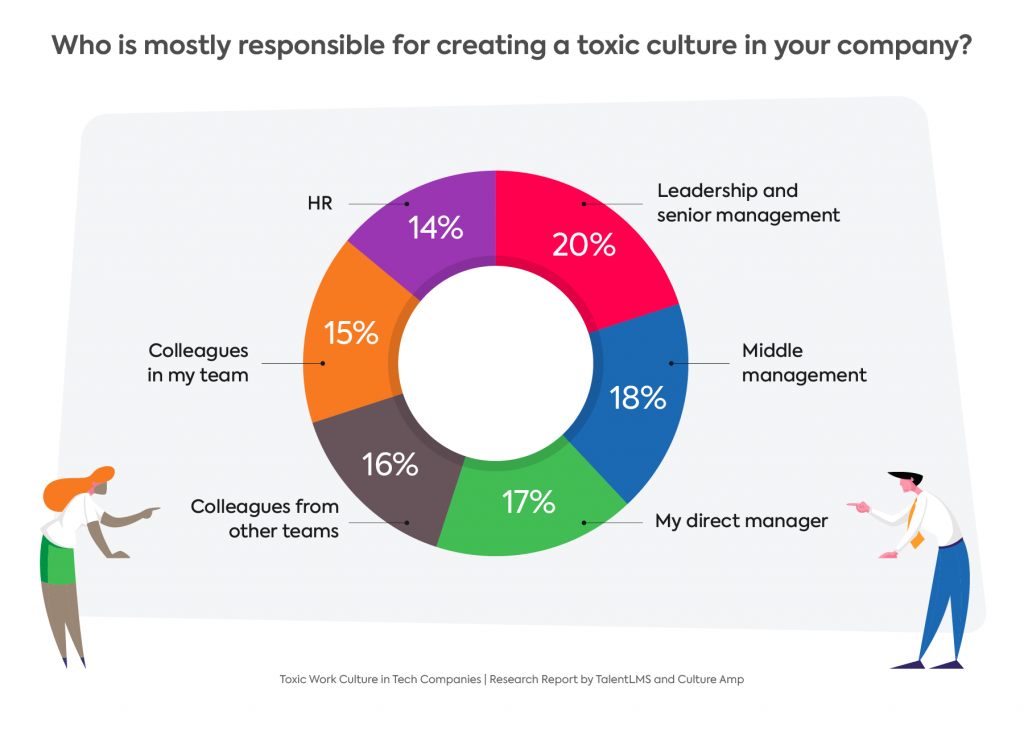
To define toxic culture, and differentiate it from a frustrating or tedious work environment, we used The Toxic Five framework developed by MIT Sloan. This framework groups the elements of toxic work culture in broader topics, and identifies five specific attributes: disrespectful, non inclusive, unethical, cutthroat, and abusive.
Key findings
45% of employees in the software industry who are working in companies with toxic work culture plan to quit their job because of toxicity.
Leadership and senior management are mostly responsible for the toxic work environment in tech companies, according to the employees.
When faced with toxic behaviors or situations, almost half (49%) of surveyed employees said they don’t do or say anything.
Recent layoffs in the tech industry have intensified a climate of toxicity in tech companies, 45% of employees agree.
Employees from the software industry say the top 3 contributors to the toxic work culture in their companies are:
1) Expecting employees to work longer hours or weekends without additional pay
2) Lack of transparency and communication from management and leadership
3) Lack of consideration and courtesy45% of employees in toxic tech companies say that leadership is unaware of the toxicity and lives in a bubble, thinking the company culture is healthy.
46% of employees in the software industry suffer from burnout because of a toxic work environment.
Workplace training can help in fostering a more positive and healthy work environment, 48% of employees agree.
To eliminate toxic work culture, 43% of employees think managerial and leadership training for leaders and managers would be helpful.
Almost half of the employees (47%) believe their companies will remain toxic in the future.
The whats and whos of toxic work culture in software companies
It is important to recognize that the toxic behaviors described in this research can have serious negative impacts on both employees and organizations. In their most extreme form, they can put the mental health of employees seriously at risk. But even moderate levels of these toxic behaviors can severely impact organizational performance by undermining employee motivation, diminishing the strength of the employer brand, and increasing regrettable attrition.
—Dr Joel Davies, Senior People Scientist at Culture Amp
The role of leadership: When perception does not match reality
Over 9 in 10 CEOs and CFOs believe that improving corporate culture would increase the value of their organization. In addition, 84% believe their company needs to improve culture. But are the leaders doing enough to actually improve it?
The data from the TalentLMS and Culture Amp research report indicate that they don’t, as employees are holding their leaders liable for the toxic work culture in their companies. The disconnect is wide and concerning: 43% say that the leadership is turning a blind eye to toxic behaviors, and 45% say that senior executives promote unhealthy competition among managers and employees.

But that’s not all. Close to half of employees (47%) agree there’s a lack of leadership and accountability within their company. Regardless of if the leadership actively contributes to a climate of toxicity, or is simply out of touch and interacts only with a few select people—that the data indicates is more likely the case—the consequences are deeply damaging. They open a way for toxicity to spread throughout the organization.
There is a common belief that ‘people leave managers, not companies.’ However, at Culture Amp, we have found perceptions of senior leadership tend to be more important for employee engagement and commitment than perceptions of one’s direct manager. Senior leaders are role models, whether they like it or not. The way they behave at work creates powerful social norms that can impact how the rest of the organization behaves. Additionally, their decisions can lead to the creation of structures and incentives that result in (often unintended) harmful consequences to employees.
—Dr Joel Davies, Senior People Scientist at Culture Amp
Leaders have a vast and disproportional influence over employees. Employees look up to their leaders, who are seting an example and modeling social norms and everyone’s behavior. Leadership that’s accountable, considerate, and open to feedback will inspire and foster these same traits throughout the workforce. And vice versa: a leadership’s lack of accountability and consideration will be reproduced and magnified across teams.
Employees often mirror executives’ behavior and attitudes. So, if leaders are turning a blind eye to misconduct, employees will too. Data confirms this: almost half of the employees don’t do or say anything in face of toxicity. And this chain reaction feeds the vicious circle of toxicity.
To do their jobs well and evolve, employees are constantly upskilling themselves, undergoing all kinds of training, and learning new things. And survey data highlights that they expect the same from their leadership.
Moreover, employees seem to believe that leaders have a thing or two to learn when it comes to guiding the collective: 43% think that managerial and leadership training for the executives would be helpful addressing toxicity. Going back to basics is a good starting point for leaders committed to put an end to toxicity and shift the culture.
The optimal approach to leadership is constantly reevaluated—as new data, practices, and leadership models surface. That’s why an essential skill of a leader is their ability to change, learn, and develop. Attentive leaders are in a state of flux, capable to relearn, reassess, and adapt. After all, how can company culture change if those leading the company don’t change too?
This attentiveness and agility can spark a company-wide transformation, by encouraging and inspiring more people to embark on the ship of changeover.
Leaders who blaze a trail don’t just talk the talk, they walk the walk. And employees will follow.
The culprits of toxic work culture
It’s human to complain. Even those who don’t work in companies with toxic culture may occasionally criticize their jobs, managers or workplaces. But the toxic culture runs much deeper than that. Its telltale signs and red flags are a distrustful atmosphere, harmful behaviors, and mistreatment and exploitation of employees.
When asked what they think the major drivers of toxicity are, employees rated off-the-clock work as the number one contributor. Labor performed outside of working hours, without additional compensation, seems to be a widespread but also deeply damaging practice that erodes trust.
It puts a heavy and unfair weight on employees’ shoulders: that of being on call at all times, making it impossible to plug off from work and achieve a work-life balance.
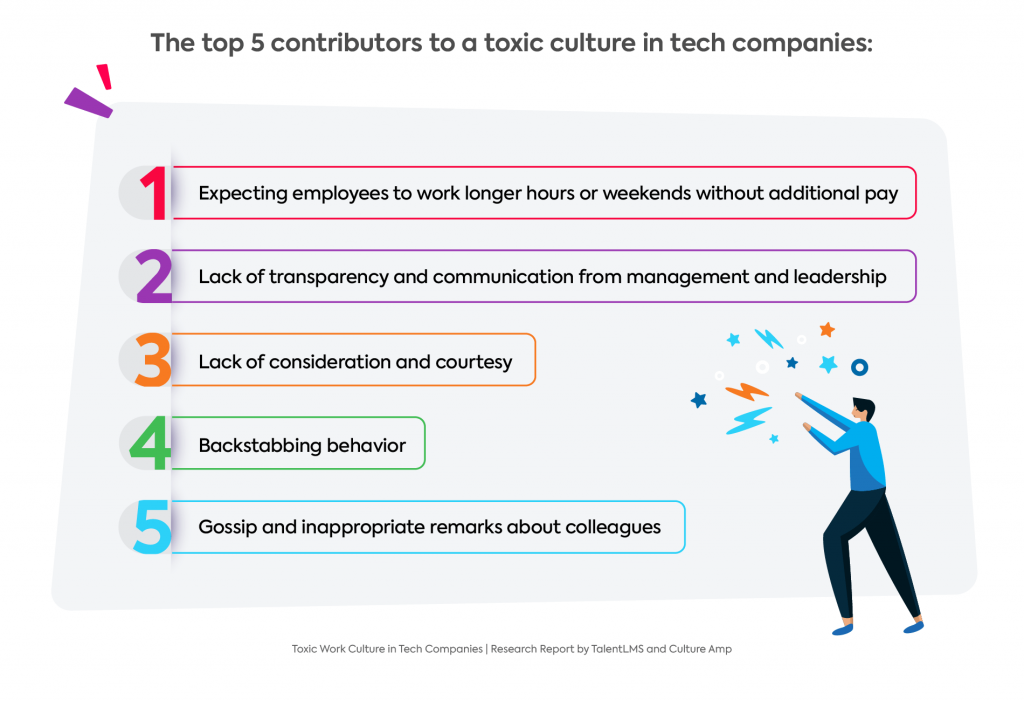
A lack of transparency and clarity in communication from leadership follows as a runner-up contributor to toxicity. Employees feel that information is withheld from them, what they seem to find highly toxic.
Next, a lack of consideration and courtesy is another big red flag of toxic culture according to employees. This lack of respect can lead to dismissive, disrespectful, and even rude interactions. On top of that, employees identified more unfriendly behaviors that contribute to toxicity: backstabbing and gossip. This is an indicator that repairing the culture means repairing the relationships between people.
But not all generations of employees in toxic culture environments seem to have the same priorities. While we can’t look into the generational differences precisely, since the survey respondents were not evenly distributed per age group, a couple of interesting differences in views arise when diving deeper into available generational data.
For example, for employees 54+ years old, the major contributor to toxic work culture is not having core values as a company, followed by a lack of consideration and courtesy. At the same time, the youngest group of employees (18-24) ranked off-the-clock work as the main contributor, but their runner-up was gossip and inappropriate remarks about colleagues.
Deconstructing toxicity: Mechanics of misconduct
Toxicity in the workplace is a monster with many heads: Unfairness, mistreatment, discrimination, harassment, offensiveness, oppression. This survey was built upon the “The Big Five” framework for identifying toxicity, and we examined how frequently related behaviors occur.
Let’s see what the results show.
Disrespectful
MIT Sloan revealed that respect toward employees rises to the top of the list of cultural elements that matter. Having respect from their peers is a basic need for professionals, and when that need is not met, it points to an out-of-balance environment.
In our survey, 42% of respondents said that managers in tech companies with toxic work cultures are frequently inconsiderate and disrespectful of employees, showing that this corrosive component of toxicity is far from being eliminated. Building respectful workplaces should be a priority for employers, along with rooting out any disrespectful behavior.
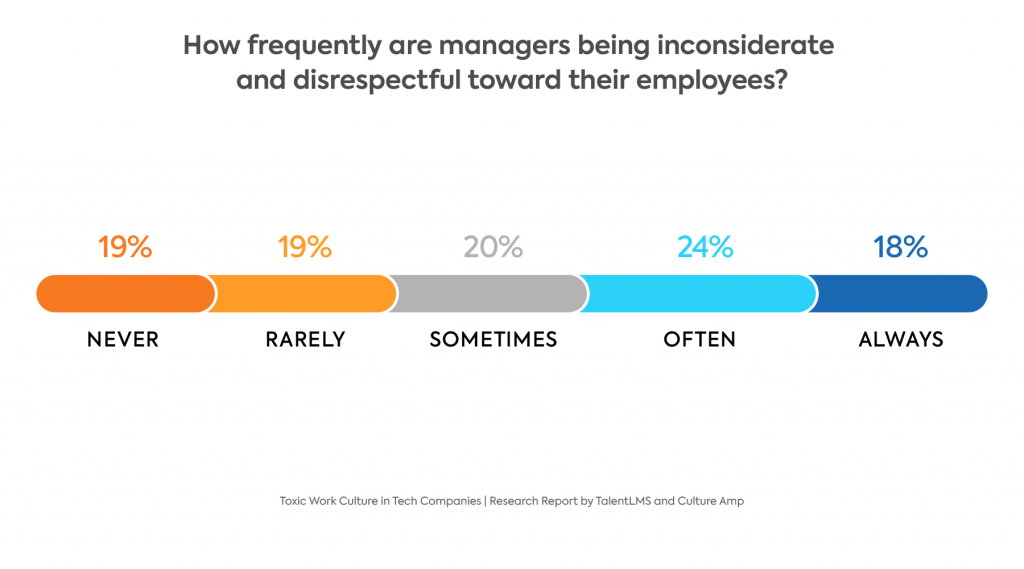
Abusive
A national study on the prevalence of workplace aggression in the U.S. has found that 13% of employees encountered workplace aggression on a weekly basis. Unfortunately, our survey also found that bullying and harassment are prevalent in the workplace: according to 40% of employees these incidents happen frequently, while 22% say they happen sometimes. Only 37% of employees responded that instances of bullying and harassment happen rarely or never. It’s spine-chilling that tech, supposedly one of the most advanced sectors, features such disturbing statistics underneath the shiny and progressive facade.

Non-inclusive
The non-inclusive environment is another major element of a broken workplace culture. A 2017 Tech Leavers study by Kapor Center reported that the majority of tech employees would have stayed in their company if it had taken steps to make the company culture more fair and inclusive. The TalentLMS and Culture Amp research report reveals that discrimination and unfair treatment—because of employees’ age, race, or gender—frequently happen in tech companies with toxic work culture, according to over 40% of respondents.
Specifically, 43% say discrimination and unfair treatment because of employees’ age happens frequently; 42% mention employees’ race as the most frequent reason; and 41% say that discrimination and unfair treatment is frequently based on employees’ gender.
Unethical
Ethics is a key component of a positive culture that inspires trust. Part of it is compensating fairly and orderly employees for the work they do. Turns out, that’s not always the case. We asked the respondents if they were expected to be on call and respond to work-related calls, messages, and emails outside of working hours. And a staggering 43% said they are, indeed, expected to do so frequently. Moreover, 44% agree they are not acknowledged and fairly rewarded for their work.
Employees not being compensated for their work means they are not treated fairly and ethically. To restore trust and rebuild morale, employers should banish these damaging practices.
Cutthroat
Another destructive ingredient of a hostile work environment is a cutthroat culture marked with backstabbing, taking credit for someone else’s work, and poor collaboration. And it appears to happen in close to half of tech companies: 42% of the respondents say antagonism and territoriality between different teams are frequent in their organizations.
At the same time, 44% of respondents said that undeserved silencing of employees—cutting them out of key meetings and decisions—frequently happens in their company. Another example of non-collegial and undermining behavior is ‘tech-shaming:’ 41% of employees say that shaming others for not knowing the latest tech tools and terms often occurs in their workplace.
Employees feel powerless when facing a toxic work culture
The data so far have revealed several dark corners of the culture in tech companies. And it’s crushing to see how powerless employees feel in the face of toxicity.

When encountering toxic behaviors or situations at work, almost half (49%) of surveyed employees said they don’t do or say anything—29% because they don’t believe it will make a difference, and 20% because they’re too nervous about the consequences.
It’s regretable to see just how many employees give up silently, without ever speaking up.
Another finding that highlights the silent despair of employees is that almost half (45%) say toxic culture has pushed them to quiet quitting. They’re left demoralized, underproductive, and silent. To speak up, employees need to be empowered—and, right now, they’re not.
It is a shame to find that so many employees feel powerless or afraid to speak up. Oftentimes, silence can perpetuate the problems in organizations because they remain hidden to those that might be able to do something about them. Shining a spotlight on deep rooted problems is the first step to creating change. Those that are brave enough to speak up (especially senior leaders) can begin to create new norms that make it easier for others to do the same.
—Dr Joel Davies, Senior People Scientist at Culture Amp
The dire cost of a toxic work culture

Unhealthy work culture causes multiple losses across an organization. But the heaviest loss is the devastating effect toxicity has on people’s health. Employees exposed to toxic behaviors or situations at work are 35% to 55% more likely to be diagnosed with a serious physical disease. In addition, multiple research suggests that when employees are experiencing unfair and unjust behaviors, their health can severely worsen.
The data from our survey confirms this: 48% of employees agree that the toxic work environment is negatively impacting their physical health.
What’s more, 45% of survey respondents agree that the toxic work environment is impacting their mental health. At the same time, 46% suffer from burnout because of it. This link between toxicity and worsened mental health is not new: McKinsey recently reported that toxic workplace behavior is the biggest predictor of employee burnout symptoms and intent to leave.
No wonder 43% of employees working in toxic software companies take PTO or sick days just to have a break from it all.
In addition to crushing the physical and mental health of employees, toxic work culture is the key driver of attrition—as numerous research has shown. Our survey confirms this link, with 45% of employees saying they plan to quit their job because of a toxic work environment.
Support the well-being of your teams.
Access a library of ready-made soft skills courses, including leading with respect, recognizing and rewarding others, and power of patience.

Data also highlights other negatively affected areas such as performance, confidence, and focus. Some of the additional findings:
- The toxic work culture negatively affects performance, 48% of employees agree.
- 45% of employees say that they often get distracted at work because of their toxic environment.
- The toxicity at work is damaging the confidence of 45% of employees.
Repairing company culture: The key components of a healthy work environment
Before we dive into the data on eliminating toxicity and creating a thriving environment, it’s important to capture exactly what a healthy work culture is. At its core, a healthy work culture is an environment where people are valued and treated with respect, equality, and fairness. It is an inclusive, considerate, and hostile-free work environment, where all members of the collective feel safe, seen, and appreciated.
Now, let’s see what the employees think are the key building blocks of a healthy culture.
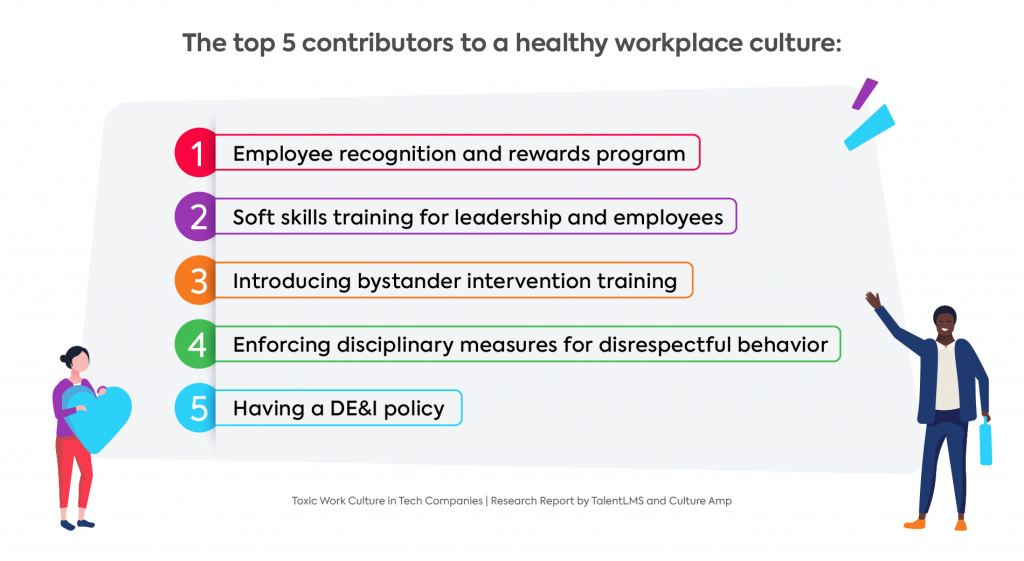
Employees in a workplace with positive culture are seen, heard, and appreciated
Employees ranked recognition and rewards programs at the top of their list of what makes a balanced work culture, showing how much they long to be heard and recognized for their work. Acknowledging employees would not just benefit them: managers who make their teams feel appreciated and supported grow successful teams that consistently deliver results.
Organizational culture can have a huge impact on motivation. While some people may be more intrinsically motivated than others, multiple organizational factors can squash the motivation that employees may start out with. For example, at Culture Amp, we have found that one of the biggest predictors of employee motivation is a perception that senior leaders demonstrate that people are important to the company’s success. Perceptions of recognition can also have a large impact on motivation. When employees don’t feel like what they put in (e.g. high workload) is worth what they get out (e.g. recognition) then they tend to lose steam and revert to doing the bare minimum.
—Dr Joel Davies, Senior People Scientist at Culture Amp
Training as a powerful ally in doing away with toxicity
Training emerged as one of the most powerful allies in building a healthy culture. A unique tool for transforming people’s views with new knowledge and information, workplace learning goes a long way in mending damaged relationships and environments.
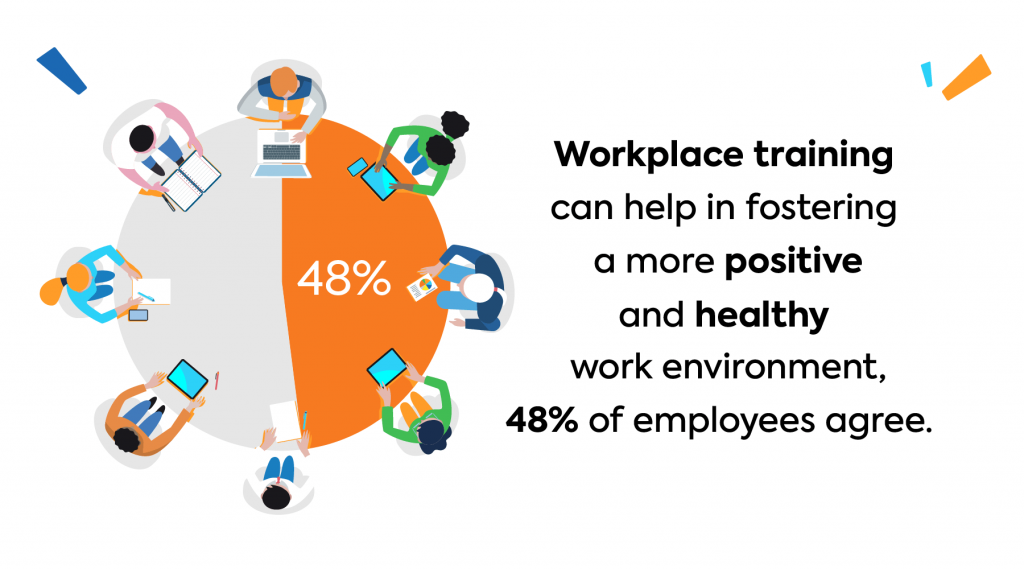
In addition, lack of training negatively impacts the ability to do their best work for almost half (45%) of employees.
Improving culture with soft skills training
Specifically, employees ranked soft skills training for leadership as the second most important ingredient of healthy workplaces—right after recognition and reward programs. Furthermore, soft skills training for all employees ranks in fourth place. The data showed that soft, or people skills are credited with fostering a positive and collaborative atmosphere at work.
Some examples are training on self-awareness, unconscious biases, DE&I, sexual harassment, and many more related topics that widen people’s horizons and make them acknowledge the blind spots of their belief systems. This kind of training can help people realize their unconscious prejudices, negative stereotypes, and adverse behavior.

Bystander intervention training
Another powerhouse training type that helps build a healthy work environment is bystander intervention training. Employees voted it as the third most important contributor to a healthy culture for a reason: It is specifically designed to prevent harassment and discrimination, by educating people on how to react proactively when witnessing others facing discrimination or harassment.
In addition to general soft skills and bystander intervention training, employees find important specific types of soft skills training, such as equity, diversity, and inclusion, empathy, types of discrimination and how to confront it, and recognizing unconscious biases and privilege.
Leadership and managerial training
4 in 10 employees said their manager knows how to lead a team, pointing out to leadership gap that training can help overcome. A recent survey by The Muse uncovered that leadership and management training is most often identified (for 43% of respondents) as a step that could have improved a toxic work environment. It’s striking to see exactly the same percent in the TalentLMS and Culture Amp research report, which also found that 43% of employees find managerial and leadership training for execs and managers helpful in eliminating toxicity.
Reinforcing a healthy culture with policies, processes, and activities
It’s encouraging to see that 32% of employees say their company has a policy against toxic behaviors at work, and employees follow it. At the same time, 26% say there is such a policy but nobody follows it in their company. Finally, 19% don’t know if such a policy exists.
Beyond creating a general policy against misconduct and ensuring employees are aware of it and follow it, let’s see what else employees think can help in repairing broken culture.

360 feedback: Showing employees that their opinion matters
46% of the respondents found applying a 360 feedback policy helpful in eliminating toxic work culture. This is the tool that gives employees an opportunity to express their opinion, as opposed to just being evaluated. With 360 feedback, they can evaluate the performance and behavior of their managers, and highlight any problematic areas. The next step for leadership is to actually listen to what the employees have said, and utilize this valuable data in the day-to-day workings of their organization.
360 degree feedback can be a powerful tool for change if rolled out correctly. If 360 degree feedback is positioned exclusively as a development exercise, people are more likely to provide honest feedback and recipients are more likely to be open to the feedback. However, 360s can sometimes backfire if they feel too evaluative in nature and/or are used to make decisions about remuneration and promotions. Additionally, it is essential that employees are encouraged to be honest and that senior leaders model the openness to feedback they want the rest of the organization to exhibit.
—Dr Joel Davies, Senior People Scientist at Culture Amp
Bring inclusivity to life through company-organized social events
Cultivating an inclusive atmosphere with respect for all kinds of diversity was found helpful in battling toxicity by 45% of employees. And there are more benefits to it: Organizations with inclusive cultures are twice as likely to meet or exceed financial goals, three times as likely to be high performing, and six times more likely to be innovative and agile, per Deloitte.
The atmosphere of acceptance for different kinds of diversity enhances safety, fairness, and belonging. It ensures that underrepresented groups have a place and a voice within teams. In addition, a climate of acceptance can be encouraged and brought to life through company-organized social events: 47% of employees have found them helpful in combating a toxic culture.
Transparency for banishing ambiguity and rebuilding trust
Toxicity thrives on ambiguity, chaos, and confusion. Those negative traits are all deeply present within a toxic organization, and hard to root out: for example, 3 in 10 employees say that their manager does not foster a culture of open and transparent communication. But resistance to change and lack of openness will not help organizations get rid of toxic work culture. Instead, in our survey, 43% of employees agreed that increasing transparency would be helpful in eliminating toxicity.
In an effort to create a more open organization and rebuild trust, employers can start sharing company information, such as goals, results, and practices with their employees. Leaders can share strategic moves, corporate values, and company news. Increased transparency has the potential to bring the organization closer to people, and vice versa. Imagine all employees living and breathing the same values and goals.
In many organizations, employees operate in silos and have little transparency into what other teams are doing. They also lack visibility into the decision making processes of their senior leaders. This can allow poor work practices and poor decision making processes to go unchallenged indefinitely. Increasing transparency can go a long way toward increasing accountability, removing ambiguity, and re-building trust.
—Dr Joel Davies, Senior People Scientist at Culture Amp
Cleaning up the workplace: Holding people accountable
In combating toxicity, 45% of employees have found it helpful when toxic coworkers are removed. Depending on the level and intensity of their toxic behaviors, it may be worth giving some people a second chance. But they need to show a willingness to take a deep look at themselves, recognize their unhealthy patterns, and understand the harmful effect of their behavior. Hard conversations like this create an opportunity for introspection and growth—for those willing to take on the journey of self-awareness.
But if the employee shows no willingness to understand their colleagues’ complaints or accept responsibility for their mistakes, and remains defensive and self-righteous, it’s unlikely that they’ll change. To root out toxicity, people who spread it should be held accountable for their behavior.
Over 4 in 10 employees (42%) found that enhancing accountability, with people owning up to their mistakes and learn from them, is helpful in eliminating toxicity.
Rooting out favoritism: Applying rules equally for all
Close to half of employees (44%) think that applying rules fairly and equally for all employees and managers can play an important part in wiping out toxicity. The special relationship that leaders develop with some of the executives and managers may prevent them from seeing those people realistically, and notice the harmful effect they have on employees. The company-wide feedback policy can encourage employees to call out toxic behaviors even if they come from the boss’s protege. And leaders have the responsibility to listen, look for patterns and see hard truths.
Embracing vulnerability to create new, positive norms
When leaders are openly talking about their doubts, mistakes, and uncertainties, they show a high level of self-awareness and a deep commitment to fix what’s broken. They foster honesty. The first step in solving any problem is the awareness that there is a problem to start with. And the leader who openly acknowledges and reflects on missteps restores confidence among employees that things will get better.
Vulnerability also means reevaluating practices that once worked but are outdated and removing structures from the past that stand in the way of a healthier workplace. One such example is hierarchy, a model that the majority of the business world once used to follow. But the most successful companies today are built around teams, not hierarchies. As a report by The Josh Bersin Company highlights, leaders nowadays don’t manage people. Instead, their new role is to train, support, align, evaluate, and move people into the right positions where they can shine.
Finally, vulnerability creates a psychologically safe environment for diverse voices to be freely expressed. And once everyone is enabled and encouraged to participate, a real dialogue can kick off—the dialogue about transforming broken cultures into thriving environments.
Any real change must begin with an acknowledgment of the problem and of the role one has played in creating that problem. When leaders are vulnerable in this way, it can engender a lot more trust and create new norms that make it easier for others to be vulnerable too. However, when leaders feel a strong need to appear competent, they can fail to admit (sometimes even to themselves) that there is a real problem worth addressing.
—Dr Joel Davies, Senior People Scientist at Culture Amp
What the future holds: From crushed expectations to restoring optimism
When it comes to whether employees who work in toxic environments believe the culture in their company will change, the results are a mixed bag. Overall, 43% don’t feel optimistic that their workplace will get healthier in the future. At the same time, 3 in 10 are positive, believing it will improve and become healthier.
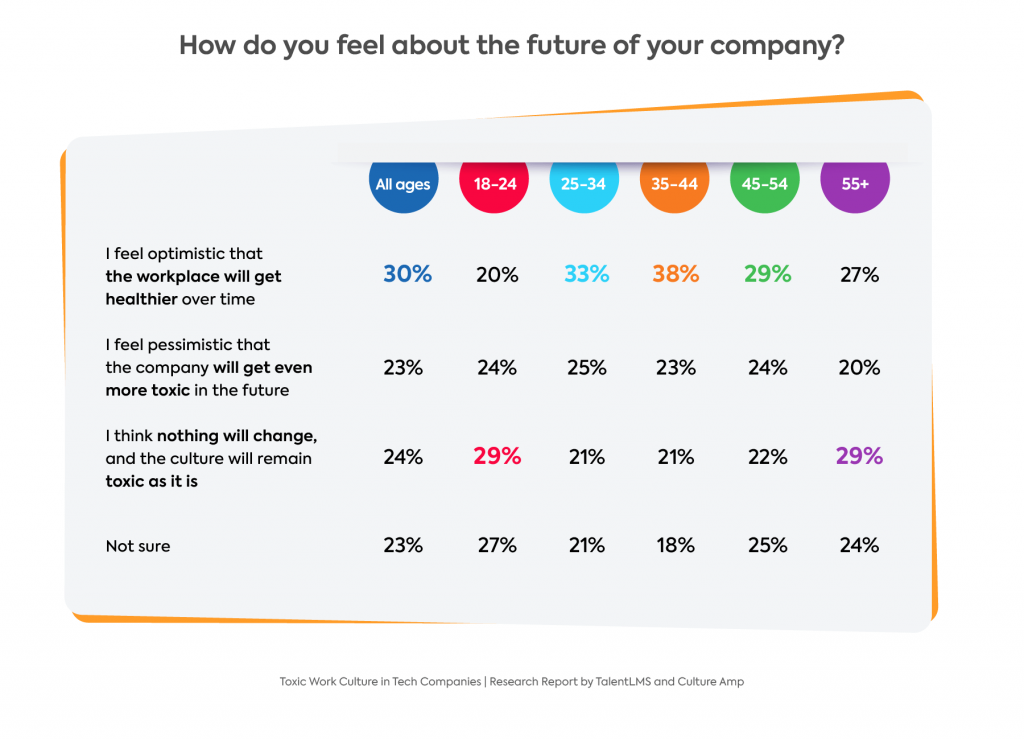
The prevalence of the pessimistic stance that toxic work culture won’t improve in the future means employees are stripped away of hope.
It is understandable that so many employees don’t expect things to change. It would be naive to expect real change if one’s organization has been unhealthy for a long time and hasn’t shown any indication that change is a priority. Employees shouldn’t feel powerless though. While they may not be able to change the whole organization, they can still have a positive impact on the people they work with by role modeling the right behaviors and calling out the unhealthy ones.
Sometimes though, the best course of action is just to leave a toxic organization. At Culture Amp, we often find that senior leaders become motivated to change their culture in response to the increased turnover of their high performers. When lots of good employees start leaving (and are honest about their reasons in their exit survey), this can spark change that others will benefit from in the future.
—Dr Joel Davies, Senior People Scientist at Culture Amp
But employers can restore feelings of optimism in the workplace by committing to put an end to toxic culture. The data from the TalentLMS and Culture Amp research report outline a plethora of ways in which leadership can create new, positive norms and structures that limit the spread of toxicity. The research unpacks effective ways for spotting and stopping toxicity, and fostering a respectful and considerate work climate.
Remodeling toxic behaviors and rebuilding broken trust is possible. And that possibility can help demoralized workforce restore hope for a more optimistic future.
About the survey
The survey of 1,000 U.S. full-time tech industry employees working in companies with toxic work culture was conducted online on February 23, 2023. Forty-seven percent of the respondents were female, and 53% were male. The TalentLMS team was responsible for survey development and analysis, and the Culture Amp team provided insights into the data.
Research team
Ana Casic (TalentLMS), Christina Pavlou (TalentLMS), Giota Gavala (TalentLMS), Joel Davies (Culture Amp)
Train your people. Measure results. Drive growth.
TalentLMS gives you the tools to supercharge every step of your training.





